Abstract
In the dynamic and fiercely competitive realm of the film industry, where artistic brilliance converges with commercial viability, success stands as the ultimate pursuit. “Cinematic Alchemy, Ingredients for Movie Magic” undertakes a comprehensive exploration into the dynamic and highly competitive landscape of the film industry, where the pursuit of success is not merely a goal but a fundamental necessity. Recognizing the industry’s relentless quest for acclaim, as evidenced by the numerous prestigious awards, our project aims to identify and analyse the critical elements that provide significant influence over a movie’s success.
Through meticulous examination of movie data which could influence both critic and audience ratings, as well as box office revenue, we seek to unravel the elusive formula that transforms a film into a blockbuster. In an era where cinematic achievement is measured not only by artistic brilliance but also by financial prowess, our data-driven analysis positions itself as an indispensable tool for filmmakers, producers, and industry stakeholders.
Introduction
Welcome to “Cinematic Alchemy: Ingredients for Movie Magic,” a project unraveling the intricate web of factors shaping the success of films. This will be done through rigorous analysis of measures intrinsic to the movie such as its genre, the themes it contains and its duration. Some more external parameters will also be part of the study in particular the timing of its release. More precisely, a closer look will be taken on the financial context as well as the release month in which the movie has entered the theatres.
Concretely, we want to test the different relationships between the variables. The following causal diagrams illustrate the different links that will be investigated along the data story. For each variable, we defined the type of success it could affect. Our success was defined in three ways: the audience rating, which is the rating given by normal people like you and me. We also use the critics’ rating. Both of these ratings are obtained through the Rotten Tomatoes database. Another measure of success that we wanted to study is box-office revenue. For the internal elements likely to affect the success of a film, we used the length of the film, the genre, which is the overall type of film, and the subject, which are the themes present in the film. Using the topics allows us to have a more fine-grained classification of movies for constructing our paired matchings. Moreover, while the genres are clustered, we are able to obtain non-disjoint topic labels which more accurately reflect the structure of the dataset. Finally, we want to assess whether the actors have an impact on the film’s revenue.
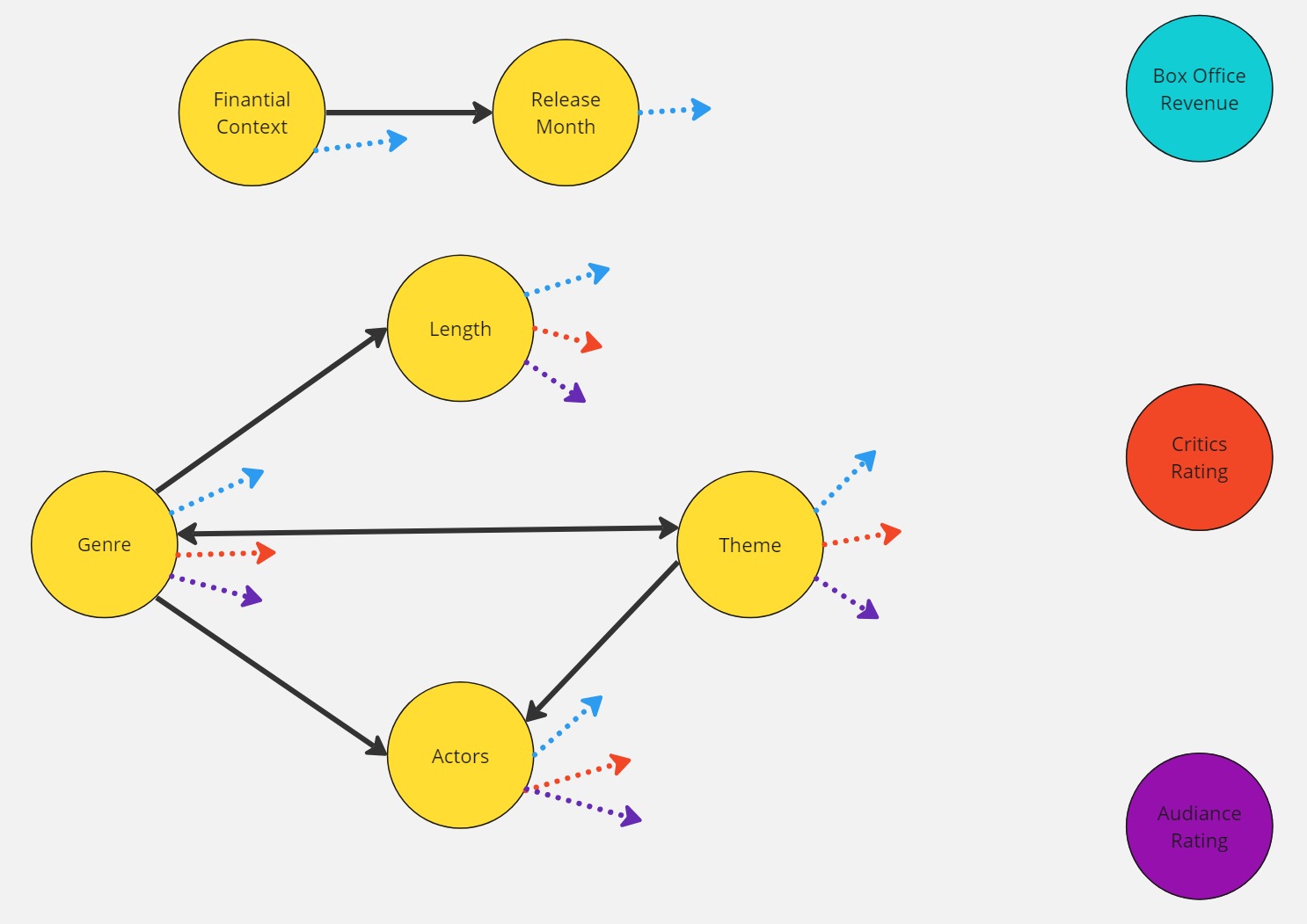
To compile the necessary data, we integrated information from three datasets. The initial dataset is sourced from the CMU Movie Summary Corpus, providing details on films for analysis including their plot, actors, and certain box office revenue figures. To increase the number of films with available box office data, we incorporated The Movies Dataset, which includes information on film budgets and revenues. Additionally, we conducted web scraping on the Rotten Tomatoes website to recover the critics. You can also find these link later in the resources tab in the navigation bar.
Correlation between success types
One might wonder if it is really necessary to consider both metrics for success. It is a fair question to be asked since one could think that they reflect the same phenomenon. But before solving such a mystery, one needs to think about which rating would make sense. There are two main types: The critic score and the audience rating. Should we consider both?
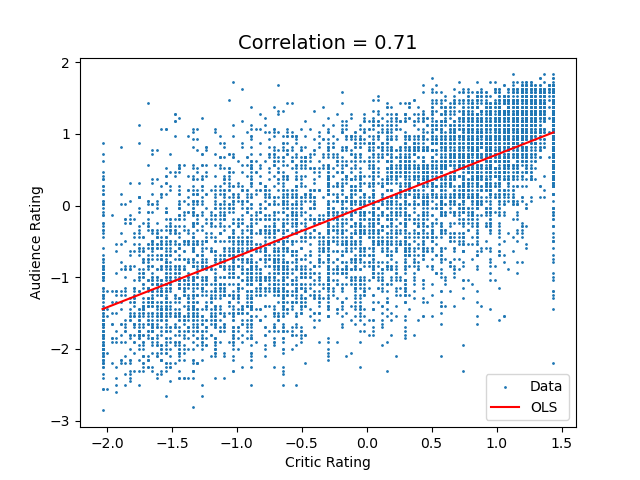
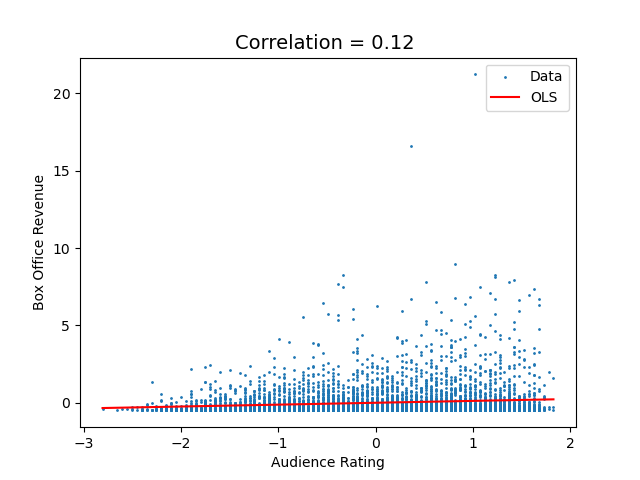
By standardising the data, one can read the correlation coefficients between the success metrics on the plot which is given by the slope of the line given by the OLS.
Where the ratings are quite well correlated, the audience score doesn’t seem to have any link with the box office revenue. Therefore, we will keep track of the audience rating and of the financial metric.
Inflation analysis
In order to compare movie revenue across the years, we need to take inflation into account. First, we obtain the inflation data from the CPI python library. We then create an inflated revenue column in our dataset, in which we adjust the box-office revenues of the films to today’s values. In the next figure, we show that the mean of movie revenue across the years increases similarly as inflation. We observe a correlation of 0.9 with a p-value smaller than 0.05. We can see some interesting facts in this figure. Firstly, the average box office revenue for movies prior to 1950 are quite noisy. There are two reasons for this: firstly, we have a smaller number of films for these periods and, as a result, a film with very high revenues will have a considerable impact on the average for the current year. Secondly, some films from these years (such as Disney hits Bambi or Snow White) have been remade over the years, but their box office revenues have been counted in the original version. After these noisy parts, we see a clear increase around 1960, while there is no particular increase in the measure of inflation. This period of high incomes lasted until around 1980, when we see a slight decline, combined with a period of high inflation. This implies the end of this golden age of cinema. Thereafter, we see what appears to be a fairly similar increase between average film revenues and inflation.
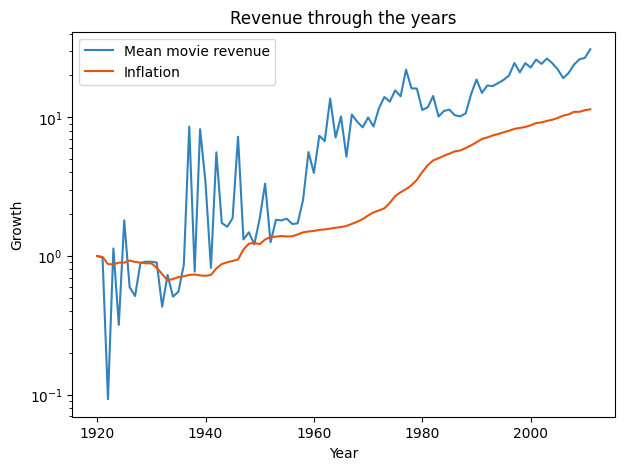
Financial analysis
Our next analysis was to compare the financial environment. To define the financial environment, we use the S&P 500 index. The S&P 500 index represents the 500 largest American companies and is one of the most commonly used criteria for determining the state of the economy in general. We obtained some daily values of the index, which enabled us to determine a general context for the economy, using the total return over a certain period. We then determined 5 states of the economy, from very good to very bad, by dividing our returns into 5 equal quantiles. Then, for each film, we were able to assign it an economic context value, from 2 for very good to -2 for very bad. We were then able to regress box-office revenues against this economic context and observe whether there was a general trend towards higher revenues for films released in a good economic context. However, our analysis did not provide us with a p-value > 0.05, so we were unable to reject the null hypothesis that film and economic context are unrelated. Even when we tried to change the number of months over which we calculated returns, or by changing the size of the quantiles, we did not obtain significant results. We can therefore assume that films are a good sector for protecting against crises. However, a more detailed analysis should be carried out to confirm this hypothesis.
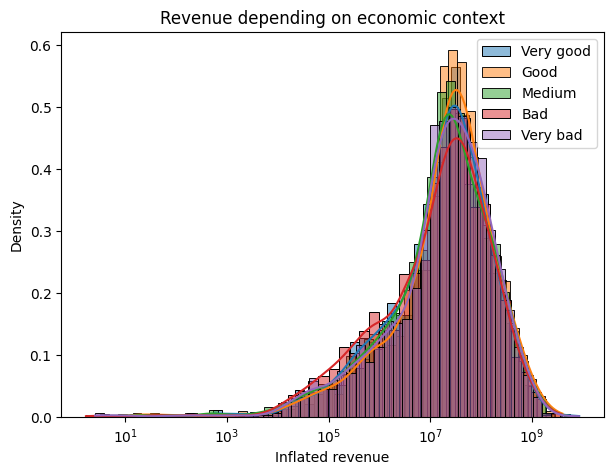
Genre clustering
As we want to compare our various success metrics across genres, we need a way to cluster the movies by their assigned set of genres. Indeed, the set of genres for each movie will partition the dataset in subsets that are too small for any statistically significant analysis.
Hence, we explore various approaches for clustering our movies along genres. A natural approach is to use the Jaccard distance, as each of our movies have an entire set of genres instead of a single genre assigned to them. However, K-means clustering implementations usually do not support smart centroid initialization techniques such as KMeans++ for the Jaccard distance, and coming up with one is out of the scope of this project. Moreover, sticking with the Euclidean metric leads to much quicker execution times.
Using silhouette analysis, we obtain an optimum of K = 16. We obtain the following clusters:
- History, Indie, Biography, Short Film, Documentary
- Comedy, Adventure, Action/Adventure, Action, Drama
- Comedy, Indie, Black-and-white, Short Film, Silent film
- Indie, Crime Fiction, Comedy, World cinema, Drama
- Drama, Comedy, Black-and-white, Romance Film, Short Film
- Romance Film, Drama, Musical, World cinema, Bollywood
- Family Film, Drama, Musical, Romance Film, Comedy
- World cinema, Comedy, Romantic drama, Romance Film, Drama
- Short Film, Indie, Drama, Silent film, Black-and-white
- Family Film, Romance Film, Comedy film, Short Film, Animation
- Indie, Family Film, Comedy, Romance Film, Romantic comedy
- Drama, Crime Fiction, Action/Adventure, Thriller, Action
- Crime Thriller, Mystery, Crime Fiction, Drama, Thriller
- Indie, Thriller, World cinema, Science Fiction, Horror
- Animation, Fantasy, Family Film, Adventure, Drama
- War film, Romance Film, Crime Fiction, Drama, Black-and-white
After we obtain clusters, we analyse the differences in each of our success metrics between clusters.
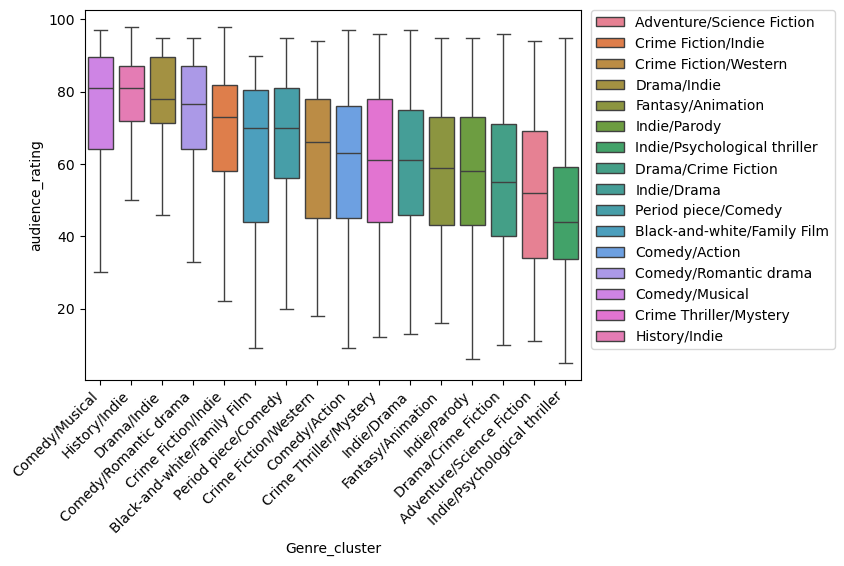
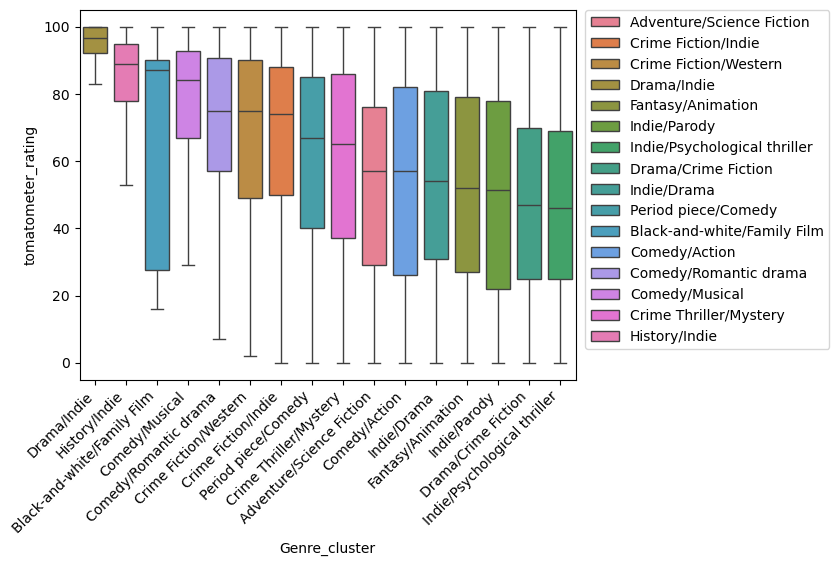
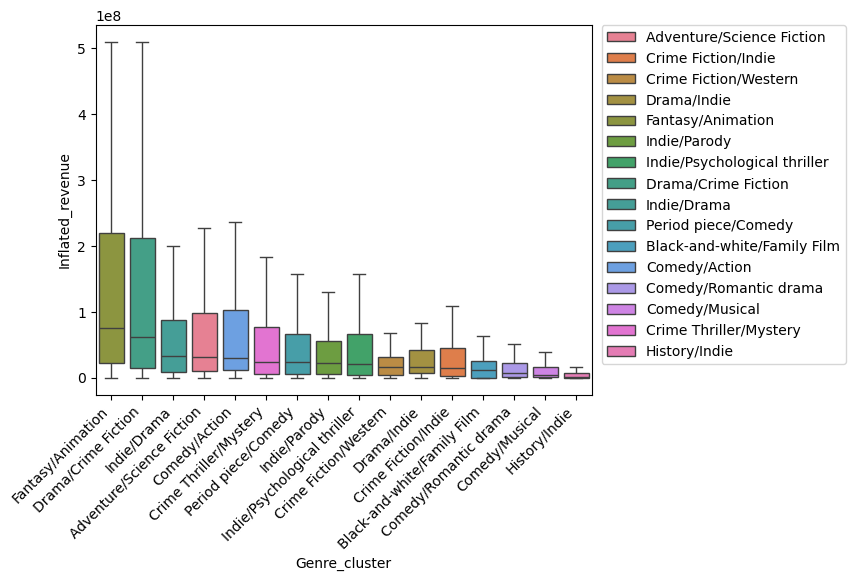
As expected, musical comedies score high in the audience rating, while artsy and older movies (black and white, history and indie movies) score higher in the critic rating. Regarding the revenue, the highest grossing genres are fantasy and crimegi fiction, which include genre-defining movies such as Snow White, which is the highest grossing movie of all time (when taking inflated revenues), as well as more recent blockbusters such as Avatar.
After fitting a linear regression model for each metric, using the genre cluster as a categorical predictor, we observe that while the genre isn’t a good predictor for the revenue (reaching an R²-value of 0.052), it seems to be influencing both the audience and critics rating, with R²-values of 0.132 and 0.111, respectively. However, further analysis is needed to conclude the existence of a causal relationship.
Topic clustering
Another way to get new insight on the success of a film is to look at their topic. For this, we used natural language processing techniques on the plot of movies such as LDA and got 11 topic clusters, each characterised by a lexicon of words. These lexicons are shown in the next graph and the title for these clusters were generated using ChatGPT given the first 20 most important words.

Through the analysis of these word clouds, it becomes evident that the majority of lexicon align thematically with films. This is good news! However, a notable exception is found in the “Behind the Scenes of Filmmaking” lexicon, indicating that certain movie plots incorporate this vocabulary into their storyline, while others do not. Leveraging these lexicons, we can categorize films based on their themes, considering that a single film may fall into several thematic categories. This is quite interesting as we can gain new alchemy insight on one film success given its theme.
We’ll explore the popularity of themes over the years. It’s evident that war and military films held significant appeal from 1940 to 1970. This is probably related to propaganda film during WW2 and the Cold War. Simultaneously, family dramas emerged as a prolific thematic genre, with a notable increase in film production in the 70s.
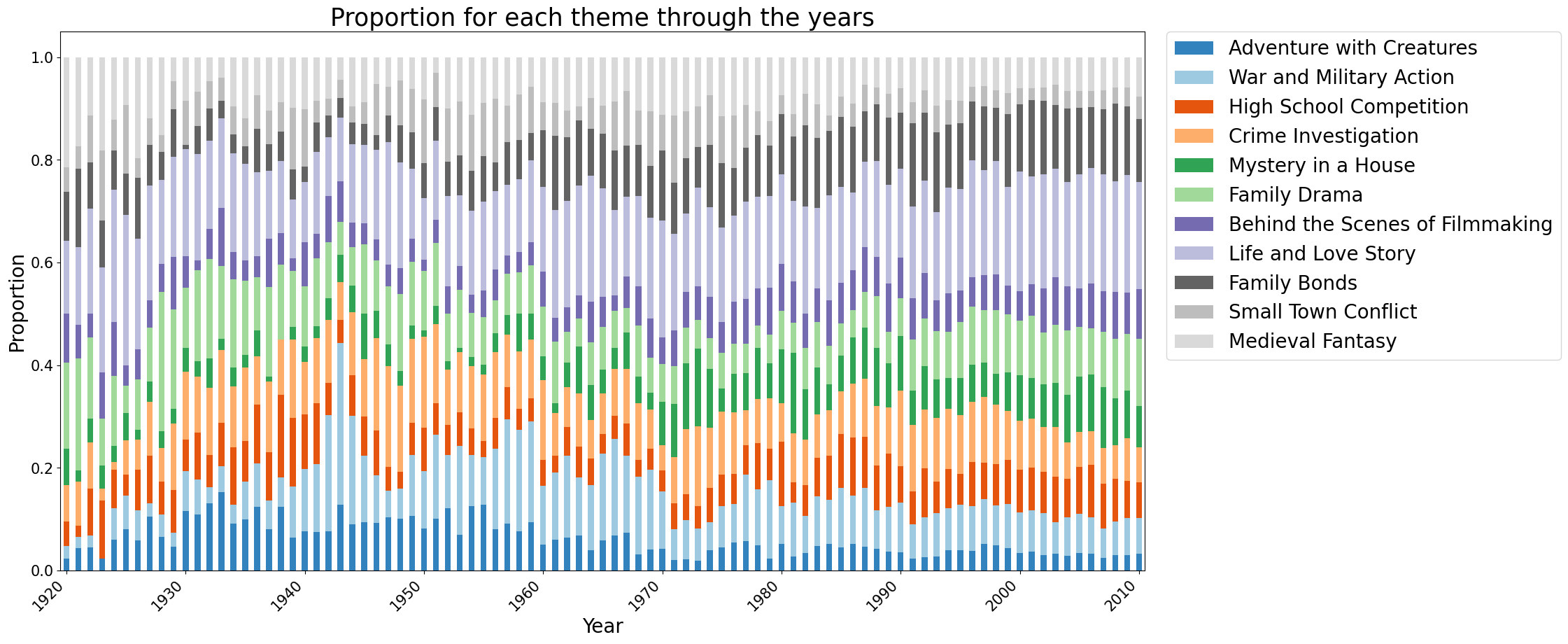
What is even more important is to look at the revenue of film per topic. This is really interesting! While some patterns can be seen in the next graph, we ran a regression using all topics to see their impact on the revenue and the results are exciting! With p-values of zero, we have that Adventure with Creatures, War and Action and Medieval Fantasy are the most profitable topics. While Life and Love Story and Family Bonds are definitely not the best topics to choose if you want to make money.
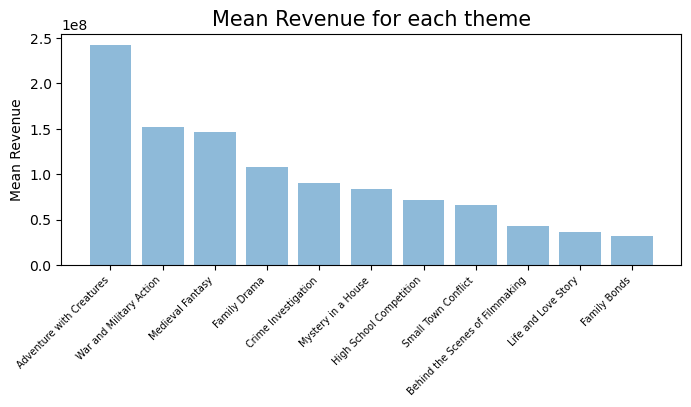
Impact of Movie Length On Inflated Revenue
As seen in our causal diagrams, we suspect that movie length influences the inflated revenue in unique ways for different movie genres. We first categorised movie lengths as Short, Medium, Long and Very Long. To keep our length categories consistent and relevant, we make sure each bin contains a similar quantity of images and that the length corresponds to the bin title. Here short movies are under 75 minutes, medium movies are between 75 and 120 minutes, long movies are between 2 hours and 2.5 hours and very long movies are over 2.5 hours. Below we see that when the movie length increases, the mean inflated revenue tends to also increase for most movie genres. However, it would be nice to compare the means for equal quantities of movies of different lengths and of the same genre.
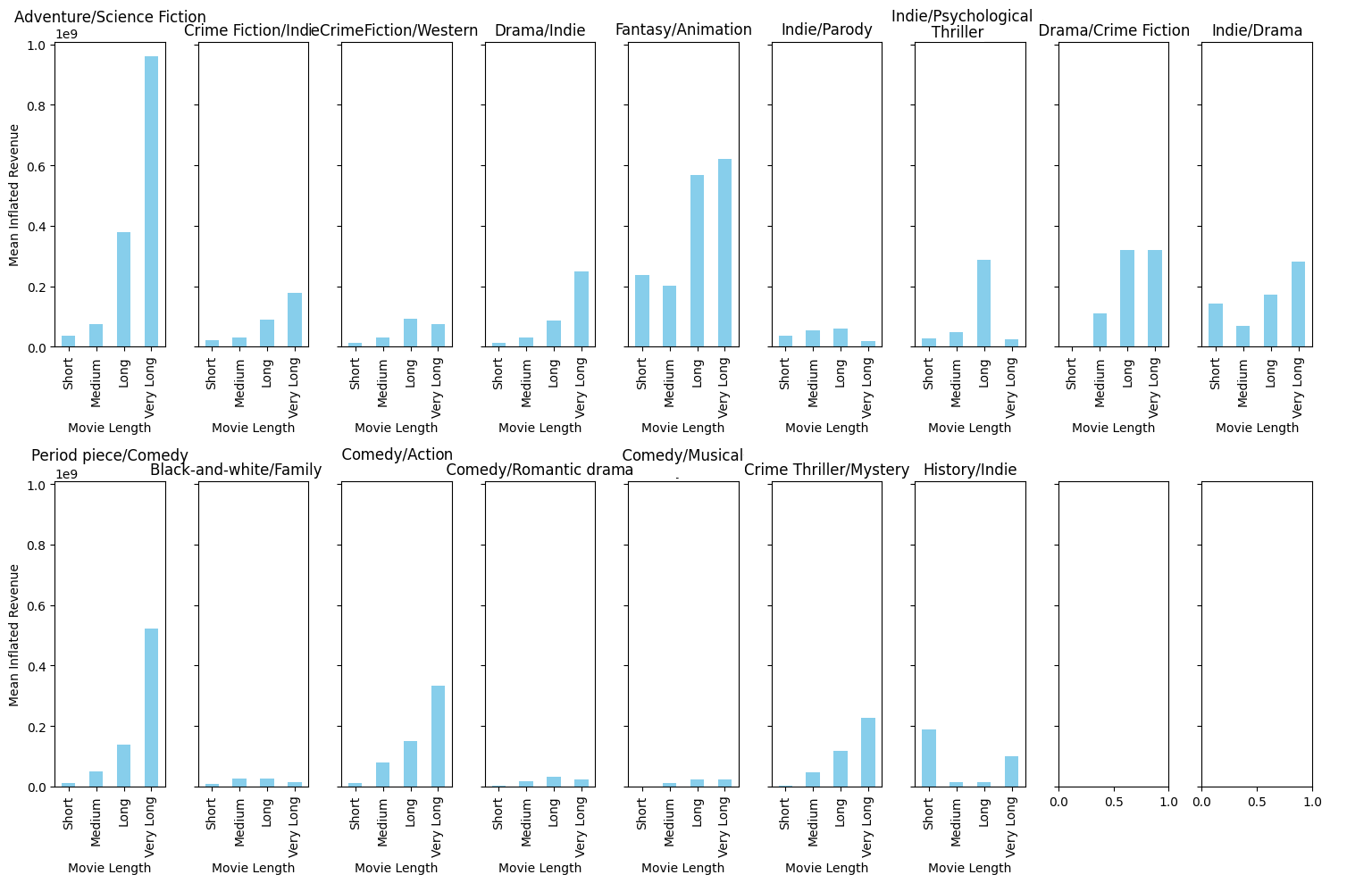
Then we performed a 1-to-1 matching to get an equal quantity of same genre movies for very long and long movies. We do so such that a positive and negative influence on inflated revenue for 2 different movie genres don’t cancel eachother out: we want to observe both!
Below you can see the mean inflated revenue for each genre cluster we computed. More importantly, we take the mean for both long and very long movies contained in our one-to-one matching to get an equal quantity of long and very long movies for each genre cluster, in order to compare them and observe any financial effects of making longer and longer movies. We see that for the vast majority of genres, very long movies tend to make more mean inflated revenue than long movies. This aligns with what we predicted.
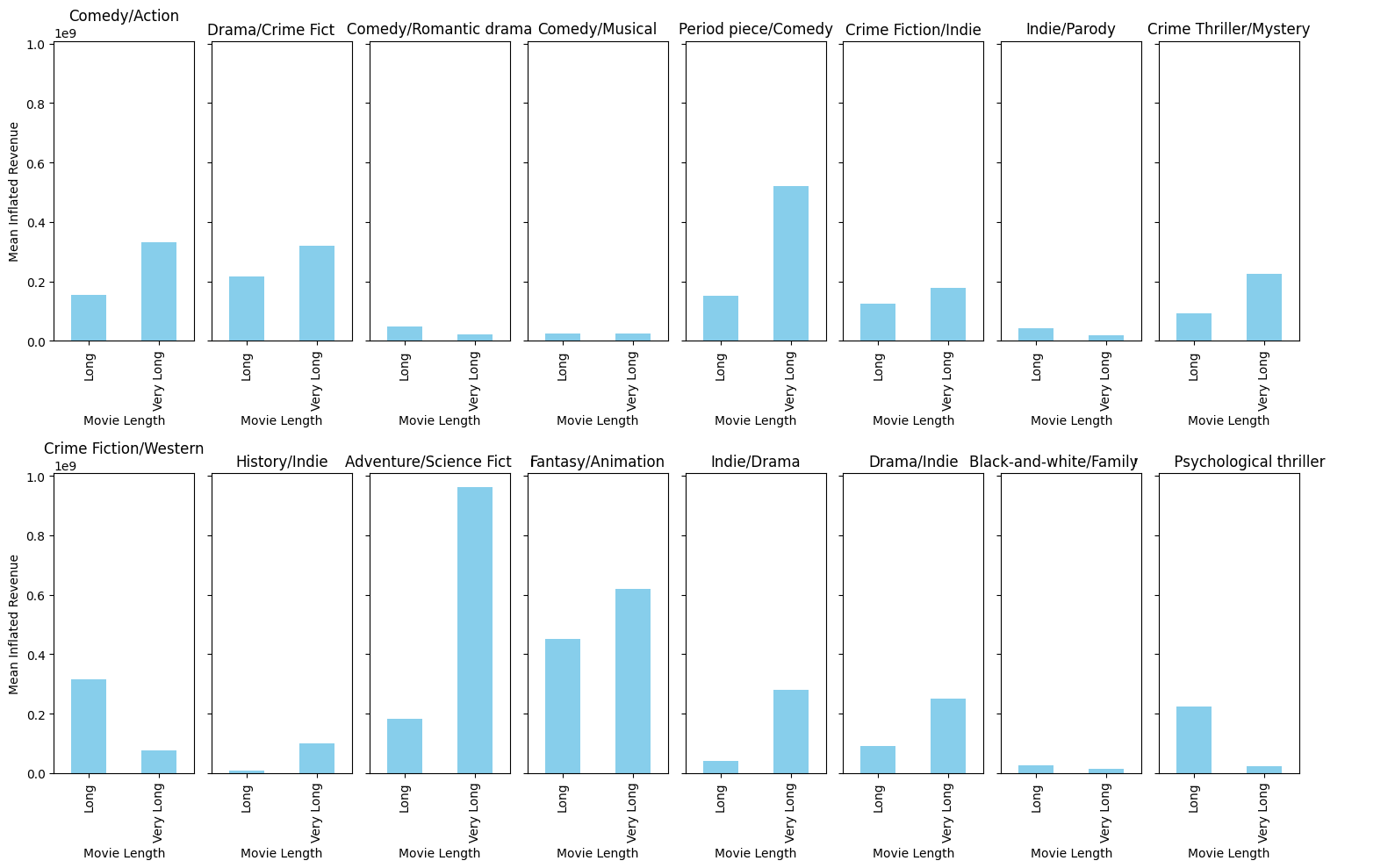
Impact of Release Month On Inflated Revenue
We suspect that the coreleasing a movie in or outside of holiday seasons influences the inflated revenue differently depending on the movie genre. We took June, July, November and December as our holiday months and built a one-to-one matching to get the same quantity of holiday and non-holiday releases for each genre. According to Ampere Analysis: “Film studios aim to take advantage of the Easter, summer and Christmas holidays by releasing light-hearted family-friendly films to which parents can take their children. These typically fall under the genres of action & adventure, comedy and animation”. For this reason, we chose to study the effects of holiday release months on Action movies.
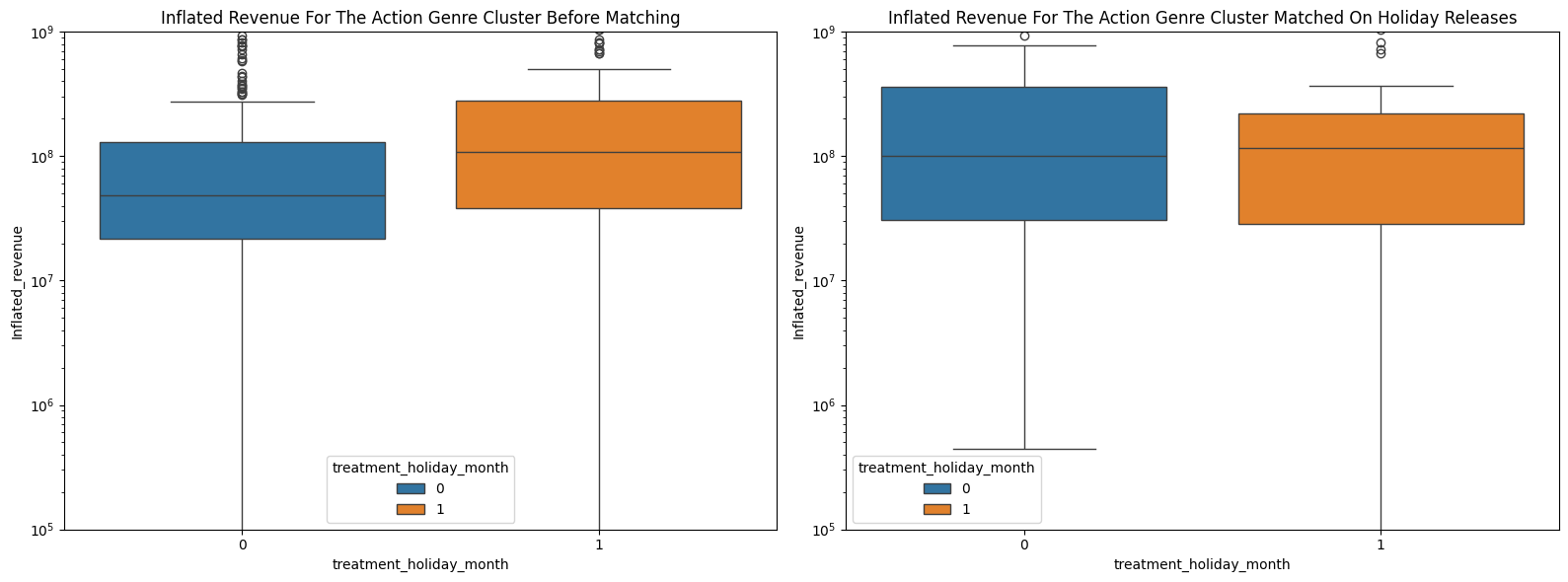
However from our boxplots, we see that whilst pre-matching action movies seemed to have a higher inflated revenue for holiday releases, the post-matching box plots show us that the inflated revenue is similar during and outside of the holiday season. This means that for an equal quantity of holiday and non-holiday released movies in the Action genre, the inflated revenue is not heavily influenced by a holiday / non-holiday release, we got the same conclusion from our regression values.
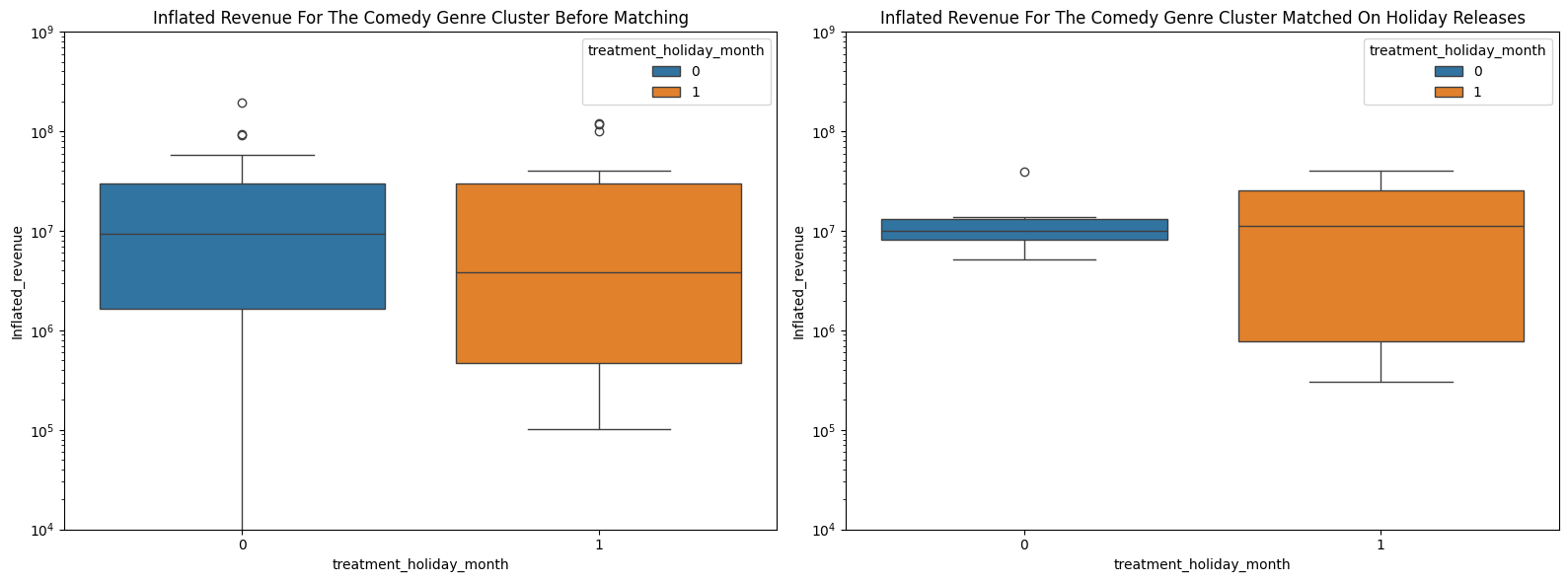
We now carry out the same analysis for comedy movies. Here the quote from Ampere Analysis makes far more sense, we clearly see that given a same quantity matching of holiday and non-holiday movies, the inflated revenue for comedy movies released in holiday months is far greater that the inflated revenue for comedy movies released outside of holiday months. This not only proves that comedy movies released during the holidays tend to make more, it also shows us that each genre can react quite differently depending on when it is released.
Actor success score
One key success factor of a film is definitely its actors, however it is really difficult to measure how actors influence our metrics. Indeed, how can we score one actor? Our idea is to use the revenue of the movies the actor played in before the movie we are looking at. To see this in action, we can look at Tom cruise movies as an example. We can see that the actor score revenue is kind of following the box office revenue of a movie.
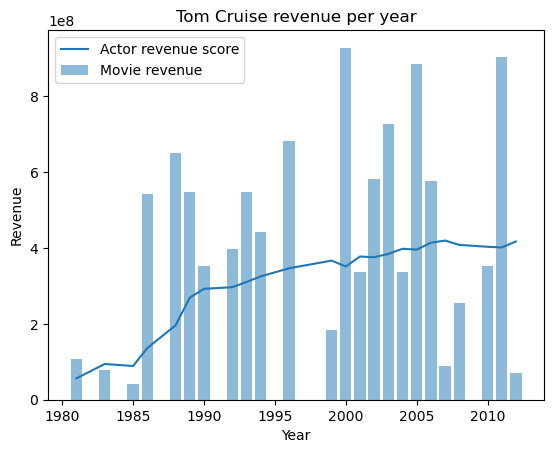
With this, we then use 3 features for each movie: the actor score revenue of the top 3 actors. We can then make a regression and the results are quite convincing with a Rsquared of 0.12 and p-values of 0.0! Even more surprisingly, the second actor score is the most important meaning that you need to have 2 good actors to make a good movie! Then the third one is still increasing the odds of making a good movie but not as much as the second one. To visualise this we used a PCA on these 3 features and make a graph with the first component and the inflated revenue. With a density plot we can see clearly where the actors are located and that the first component is correlated with the inflated revenue!
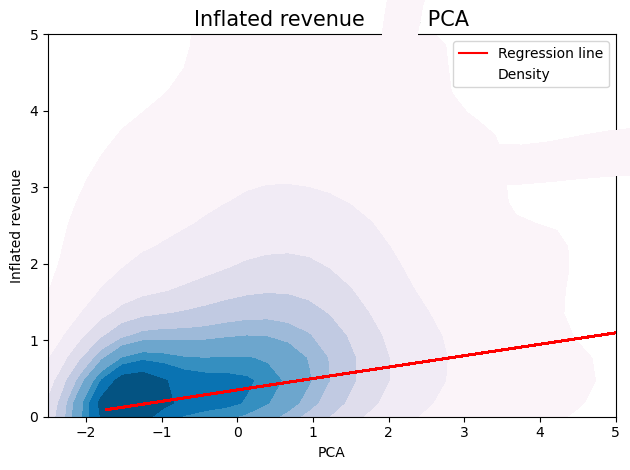
Conclusion
“Cinematic Alchemy: Ingredients for Movie Magic” attempted to unravel the complex dynamics of film success, blending artistic brilliance with financial viability. Our data-driven analysis explored correlations between movie attributes and different success metrics and assessed the impact of several factors, including economic contexts, themes, or movie length.

Throughout our analysis, the robustness of the movie industry to economic fluctuations has been highlighted, making the seventh art a solid business during uncertain financial periods. In terms of genre, the movies have been splitted into 16 different types using a clustering algorithm. In particular, relationships between this attribute and the box office revenue have been discovered. In particular, the Fantasy/Animation as well as the Drama/Crime Fiction categories tend to have higher financial success. A deeper dive would be needed to determine the causal nature of this link. To refine the research, an additional clustering on the topic has been conducted using movies’ plots which lead to 11 distinct groups. Based on that, some analysis brought to light a prevalence of war themed films between 1940 and 1970. Through the lens of a businessman, we noticed that the themes Adventure with Creatures, War and Military Action and Medieval Fantasy were the most financially attractive. The next analysis was focusing on the length of the movie. As a result, the revenue turned out to be higher for very long movies compared with just long movies. Looking for the ideal timing of release, some data exploration and manipulation has been performed. From this study, we can conclude that, for certain genres, distributing moves during the holidays tends to make more money. In addition, the revenue difference between holidays and non-holidays periods can differ depending on the genre. Finally, a compelling link between successful actors and the financial success of a movie by performing a linear regression. There’s a strong relation between the presence of a second famous actor and the box office revenue.
The study presented key relations between movie success and several internal and external factors. While no foolproof formula emerged, “Cinematic Alchemy” equips filmmakers and industry stakeholders with valuable insights, guiding them through the intricate landscape of the film industry. As the cinematic saga continues, this project stands as a significant contribution to understanding the magic behind movie success.